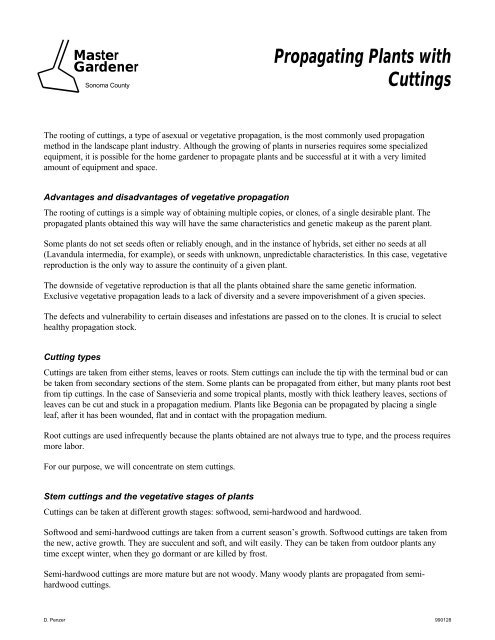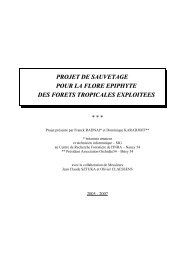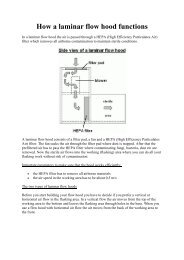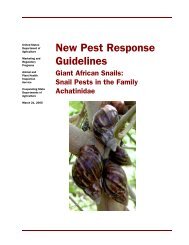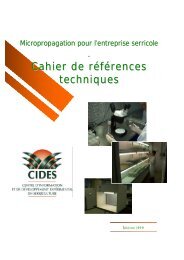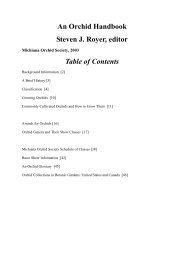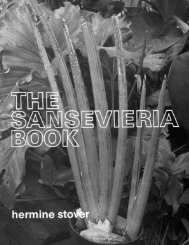Propagating Plants with Cuttings
Propagating Plants with Cuttings
Propagating Plants with Cuttings
Create successful ePaper yourself
Turn your PDF publications into a flip-book with our unique Google optimized e-Paper software.
MasterGardenerSonoma County<strong>Propagating</strong> <strong>Plants</strong> <strong>with</strong><strong>Cuttings</strong>The rooting of cuttings, a type of asexual or vegetative propagation, is the most commonly used propagationmethod in the landscape plant industry. Although the growing of plants in nurseries requires some specializedequipment, it is possible for the home gardener to propagate plants and be successful at it <strong>with</strong> a very limitedamount of equipment and space.Advantages and disadvantages of vegetative propagationThe rooting of cuttings is a simple way of obtaining multiple copies, or clones, of a single desirable plant. Thepropagated plants obtained this way will have the same characteristics and genetic makeup as the parent plant.Some plants do not set seeds often or reliably enough, and in the instance of hybrids, set either no seeds at all(Lavandula intermedia, for example), or seeds <strong>with</strong> unknown, unpredictable characteristics. In this case, vegetativereproduction is the only way to assure the continuity of a given plant.The downside of vegetative reproduction is that all the plants obtained share the same genetic information.Exclusive vegetative propagation leads to a lack of diversity and a severe impoverishment of a given species.The defects and vulnerability to certain diseases and infestations are passed on to the clones. It is crucial to selecthealthy propagation stock.Cutting types<strong>Cuttings</strong> are taken from either stems, leaves or roots. Stem cuttings can include the tip <strong>with</strong> the terminal bud or canbe taken from secondary sections of the stem. Some plants can be propagated from either, but many plants root bestfrom tip cuttings. In the case of Sansevieria and some tropical plants, mostly <strong>with</strong> thick leathery leaves, sections ofleaves can be cut and stuck in a propagation medium. <strong>Plants</strong> like Begonia can be propagated by placing a singleleaf, after it has been wounded, flat and in contact <strong>with</strong> the propagation medium.Root cuttings are used infrequently because the plants obtained are not always true to type, and the process requiresmore labor.For our purpose, we will concentrate on stem cuttings.Stem cuttings and the vegetative stages of plants<strong>Cuttings</strong> can be taken at different growth stages: softwood, semi-hardwood and hardwood.Softwood and semi-hardwood cuttings are taken from a current season’s growth. Softwood cuttings are taken fromthe new, active growth. They are succulent and soft, and wilt easily. They can be taken from outdoor plants anytime except winter, when they go dormant or are killed by frost.Semi-hardwood cuttings are more mature but are not woody. Many woody plants are propagated from semihardwoodcuttings.D. Penzer 990128
Semi-hardwood is usually characterized by a snap when bent; the tissue is firm enough to stay intact when bent, butnot woody enough to spring back. Hardwood cuttings are generally thought of as last year’s growth, whether thecuttings are taken just before or during the dormant period. Many deciduous plants can be propagated in the wintermonths from hardwood cuttings. Hardwood cuttings are mature enough to spring back when bent.Rooting HormonesAuxins are the growth hormones responsible for the rooting of cuttings. They are produced primarily in plant shootmeristems. They stimulate root initiation and development. Tip cuttings, which include the apical meristem area, arethe primary site of auxin production. Auxins are transported down the stems to other plant parts. The concentrationof auxins in plant tissue at any one time varies from plant to plant, tissue maturity, the time of year, and theenvironment. The primary auxin produced in the plant is indoleacetic acid (IAA), but synthetic auxins arecommonly used to propagate plants. The two most common synthetic auxins are indolebutyric acid (IBA) andnaphthalenacetic acid (NAA). In commercial brands, especially those intended for the home gardener, thesehormones are mixed <strong>with</strong> talcum powder, for ease of use and a longer shelf life.Taking <strong>Cuttings</strong>The best cutting materials come from the parts of a plant which are actively growing and exposed to light. Late inthe season, when growth is slowing down, the best shoots for propagation are often basal shoots, inside the plant,under the foliage.Parts <strong>with</strong> flowers or flower buds do not make good cuttings.You can pot some of your plants in the fall, cut them back for optimum shoot development, place them in a well lit,protected area, and use them as cutting stock when they resume their growth.Since the auxins are produced in the new leaves and tips, it is wise to look for the newest growth to take cuttingsfrom.Pruners or scissors work best when taking cuttings. The stock plant should not be damaged. A messy cut willencourage disease. Cut about 1/4 to a 1/2 inch above a leaf node, depending on the size and kind of plant. Unlessthe internode is very long, as in some climbing vines, do not cut the stem back. Roots develop more easily from thebottom portion of the stem between two nodes.The younger the cutting, the more you will need to protect it from dehydration. Wrap it in paper towels, grass orany moist material and place it in a plastic bag, if possible, away from sunlight. Once home, you can wrap thecuttings in damp paper towels and place them in a zip lock or other plastic bag <strong>with</strong> some air in it. They will keepfor several days in the refrigerator.Propagation mediaThe ideal propagation medium is porous, drains easily and retains moisture. Common propagation media include(1) coarse sand, (2) equal volumes of peat and perlite, (3) equal volumes of vermiculite and perlite, (4) ground pinebark and (5) three parts peat and one part coarse sand.I have had very good luck <strong>with</strong> a mixture of three parts peat, two parts vermiculite, one part (seedless, preferably)compost, one part worm castings. Compost and worm castings provide nutrients to a diversity of plants at differentstages of rooting, <strong>with</strong>out harming any.D. Penzer 990128
If you use peat, please do not use peat moss. Although it is a perfect medium, it comes from peat bogs in Canadawhich are being depleted at an alarming rate. An excellent substitute is coco peat, taken from the husk of coconuts.It is cheaper, less acid, lasts longer, and some say it is better. I have found it to be just as good.Always prepare your medium in advance, at least 24 hours, and keep it moist, but not wet.Very good quality potting soil can also be used, but it often contains wood which is either too coarse or notcomposted enough. There is too much variability from one brand to the next, or even from one bag to another of thesame brand. Whichever formula you decide to use, remember that to root, a cutting requires contact <strong>with</strong> themedium as well as air and humidity. A coarse medium will slow down the process by creating wet and dry pockets.A compact medium will encourage anaerobic conditions, making rotting likely.Propagation containersPlastic containers are commonly used for rooting cuttings. Most commercial propagators produce “liners”. Linersare individual plants rooted in trays divided into a varying number of cells. Once the cuttings are rooted, they arequickly repotted into larger containers. For a home environment, plastic containers present certain difficulties. Themoisture level is hard to monitor and consistency is almost impossible to achieve <strong>with</strong>out an automatic mistingsystem. I have found a wooden box to be the easiest and most reliable container for rooting a variety of cuttings. Itssize has to be such that it can be carried <strong>with</strong> ease. An empty wine box is very suitable for this purpose. Unlikeplastic, wood does not encourage bacterial growth. It is porous, wicks away excess moisture, making wateringaccidents less damaging. The depth of the box makes for more flexibility than a shallow tray when rooting differentkinds of plants at the same time.Preparing cuttings<strong>Cuttings</strong> should be cut <strong>with</strong> a sharp tool. The bottom leaves have to be cut off or stripped from the stem. Strippingthem can damage the cambium, causing vulnerable wounds, so it is better to cut them off. This is particularlyimportant during winter when rooting can take several months. The buried leaves tend to rot, making the wholecutting susceptible to disease and less likely to root. Because natural auxins are produced in actively growing plantparts, it can be helpful to use rooting hormones when rooting semi-hardwood or hardwood cuttings, especially inthe winter and any time a cutting does not show active growth. The use of rooting hormones does not seemnecessary <strong>with</strong> softwood cuttings showing new leaves in the spring and summer. When using hormones, simply dipthe cutting, and remove the excess <strong>with</strong> a gentle tap. Hardwood cuttings will sometimes root better if a thin sliver ofthe bark at the base of the stem is cut away to expose some of the cambium.<strong>Plants</strong> <strong>with</strong> succulent stems, like Pelargoniums, benefit greatly by being left in the shade <strong>with</strong> the cut exposed to airovernight. The cut hardens and seals, making it more resistant to insect damage and rot.PIacing the cuttings in the rooting mediumPlacing the cuttings in the rooting medium is called “sticking”. The medium has to be damp and the surface even.Holes should be punched into the medium to allow for the inserting of the cuttings <strong>with</strong>out damaging the cambiumor removing the rooting hormones, if any were used. I like to use a short phillips-head screw driver for this purpose.After the cuttings are stuck, the rooting medium can be pressed slightly around them. You can water gently <strong>with</strong> afine spray to firm up the medium around the cuttings. Do not pack the medium, a certain amount of air is desirable.Caring for the rooting cuttings and transplanting once rootedOnce the cuttings are in the box, they have to be preserved from drying and sudden changes of temperature. Placethe box in a well lit area away from direct sunlight, protected from extreme heat and cold. Keep the medium moist.D. Penzer 990128
If the atmospheric humidity is insufficient, you may need to make some kind of a frame (wire works well) covered<strong>with</strong> a plastic sheet which does not touch the cuttings. You must have enough air circulation between the protectivecover and the propagules. After a few days, the cuttings should have perked up. When you notice new growth,which can take an average of ten days to two months (depending on the season, the kind of plant and the vegetativestage), there is a good chance that the roots are developing. Root development is also called “striking”. If you tuggently at the cutting, you can feel some resistance. While holding the cutting by one leaf, insert a narrow tool underthe cutting and the roots (I use another screwdriver, a long one, this time), and pull straight up. You will notice thenew roots developing just above the callus. Callusing and rooting are independent from each other. Callusing is aprocess by which a plant closes a wound. The cambium cells proliferate to cover the whole cut. When the roots arebetween one and two inches, or about as large as the canopy, transplant the cutting into a three or four inch pot. Ifind it better to transplant into a pot than directly into the ground. The root ball is less vulnerable if it is well formedand surrounded by a protective layer of soil. In a pot, a new plant can be acclimated to the outdoors progressively.Sometimes, a cutting will show new growth, but it will have no root development. Upon observation, you willnotice that the part exposed to the medium has decayed. Cut off the decayed part, apply rooting hormones to theremaining part, and stick it again. This will happen more during the winter months. If you can keep your cuttingsalive until the month of February, there is a good chance that they will root easily from then on.If you have been successful <strong>with</strong> your fall or winter cuttings, they have rooted, you have transplanted them, andthey are showing healthy new growth. You can now use these new plants as propagation stock. The new growthwill root very fast at this time. You must leave some new growth on the plant, at least some lateral young buds anda few formed leaves. At this point, most new cuttings need only be about one to two inches long. Most of them willtake about one to two weeks to root, and the growth will be quite strong, sometimes stronger and healthier than thatof the original plant.Propagation can become a bad habit, bordering on addiction. Before you start, decide how much space you aregoing to give to it. The sticking part requires almost no room. Five-hundred cuttings can root happily in two boxes.Five-hundred potted plants, however, do require a significant amount of space. It is a good idea, strategically, tostart some rooting before the winter months (September and October work well). If you have a limited amount ofspace, you do not have to transplant the rooted cuttings right away. kept in the box, they will grow slowly, but theywill provide you <strong>with</strong> enough good softwood material for late winter propagation, before outdoor plants show anygrowth. This softwood will root quickly. By mid-spring, you will be able to set the newly rooted and potted plantsoutside in a protected area. If you grow cold resistant perennials, you can start transplanting them into your gardenafter a short period of hardening. It is best to have them in the ground by June, before the weather turns hot androot growth slows down. When you are done propagating from your original propagation box, you can take theplants out of it in one block, divide the matted mess, plant in individual containers or directly into your garden. Ifyou start cuttings from the new growth of outdoor plants in late spring, they will root fast and you can soontransplant them, but during hot weather, you will have to make sure that they do not dry out before they are fullyestablished, which can take a month or two.Propagation is so simple, and there are so many plants, out there...D. Penzer 990128


